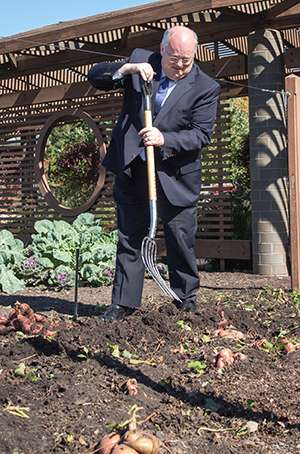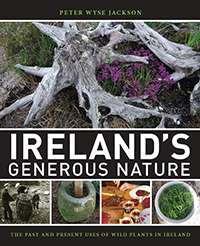Rediscovering Ireland's rich history of wild plants

Ireland lost one million souls to hunger and disease during the potato famine and another million to immigration. But that's not all, says Peter Wyse Jackson, PhD, president of the Missouri Botanical Garden and the George Engelmann Professor of Botany at Washington University in St. Louis.
Ireland also lost its connection to the many plant species that sustained its people throughout the centuries.
Wyse Jackson has recovered much of that history in his book "Ireland's Generous Nature: The Past and Present Uses of Wild Plants in Ireland" (2014), a comprehensive and engaging look at Ireland's 900 native species and their surprising uses. Wyse found that one-third of Ireland's native flora possessed medicinal qualities and that 100 species are edible.
"Wild plants were really the basis of so much life in Ireland for almost any purpose you could think of—food, medicine, fuel, fibers—it goes on and on," said Wyse Jackson, who was born in Kilkenny, Ireland, and served as director of the National Botanic Gardens of Ireland before arriving in St. Louis in 2010.
"Yet that traditional knowledge is very scattered today in part because of the potato famine," he said. "The harvesting and collecting of wild plants from the countryside or seaside came to be regarded as a symbol of poverty."
The potato is native to South America. Introduced to Europe as early as the 1530s, potatoes became Ireland's dominant crop by the early 1800s. Unlike other foods, potatoes don't demand particularly rich soil and can thrive in cool, damp conditions.
"The potato is so productive," Wyse Jackson said. "One and one-half acres of potatoes would provide food for five to six people for a year, whereas the equivalent cereal (crop) needed four to six times that amount of land. It wasn't unusual for a man to consume 14 pounds of potatoes a day."

So when the potato blight arrived in Europe in 1845, Ireland was particularly devastated. The disease wiped out half of the crop within ten weeks.
"In some parts of Ireland, potatoes were more or less the only significant crop," Wyse Jackson said. "The consequences forever changed Ireland and, really, the countries where the Irish immigrated to. It was a watershed moment for the country."
Wyse Jackson is an ethnobotanist—a scientist who studies the relationship among people, cultures and plants. He leads a team of researchers at the Missouri Botanical Garden who work around the globe, cataloging and studying plants and their purposes. Though many of us view botanical gardens as place to enjoy nature's beauty, they historically have been centers of science, Wyse Jackson said.
"When the first botanical garden opened in Pisa nearly 500 years ago, the purpose was to teach students about the medicinal uses of plants," Wyse Jackson said. "We still take that role very seriously."
Climate change and habitat loss make a botanist's work more urgent than ever.
"One-quarter of the world's plants are in danger of extinction," Wyse Jackson said. "If we don't safeguard wild plants throughout the world, we risk losing so many resources we may well need in the future. Many rural communities around the world still rely on plants for everyday healthcare."
Provided by Washington University in St. Louis




















